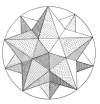
Sacred Texts Sky Lore Index Previous Next

Harmonies of the World, by Johannes Kepler, tr. Charles Glenn Wallis [1939], at sacred-texts.com
[271] It has been said in the second book how the regular plane figures are fitted together to form solids; there we spoke of the five regular solids, among others, on account of the plane figures. Nevertheless their number, five, was there demonstrated; and it was added why they were designated by the Platonists as the figures of the world, and to what element any solid was compared on account of what property. But now, in the anteroom of this book, I must speak again concerning these figures, on their own account, not on account of the planes, as much as suffices for the celestial harmonies; the reader will find the rest in the Epitome of Astronomy, Volume II, Book Iv.
Accordingly, from the Mysterium Cosmographicum, let me here briefly inculcate the order of the five solids in the world, whereof three are primary and two secondary. For the cube (1) is the outmost and the most spacious, because firstborn and having the nature [rationem] of a whole, in the very form of its generation. There follows the tetrahedron (2), as if made a part, by cutting up the cube; nevertheless it is primary too, with a solid trilinear angle, like the cube. Within the tetrahedron is the dodecahedron (3), the last of primary figures, namely, like a solid composed of parts of a cube and similar parts of a tetrahedron, i.e., of irregular tetrahedrons, wherewith the cube inside is roofed over. Next in order is the icosahedron (4) on account of its similarity, the last of the secondary figures and having a plurilinear solid angle. The octahedron (6) is inmost, which is similar to the cube and the first of the secondary figures and to which as inscriptile the first place is due, just as the first outside place is due to the cube as circumscriptile.
[272] However, there are as it were two noteworthy weddings of these figures, made from different classes: the males, the cube and the dodecahedron, among the primary; the females, the octahedron and the icosahedron, among the secondary, to which is added one as it were bachelor or hermaphrodite, the tetrahedron, because it is inscribed in itself, just as those female solids are inscribed in the males and are as it were subject to them, and have the signs of the feminine sex, opposite the masculine, namely, angles opposite planes. Moreover, just as the tetrahedron is the element, bowels, and as it were rib of the male
cube, so the feminine octahedron is the element and part of the tetrahedron in another way; and thus the tetrahedron mediates in this marriage.
The main difference in these wedlocks or family relationships consists in the following: the ratio of the cube is rational. For the tetrahedron is one third of the body of the cube, and the octahedron half of the tetrahedron, one sixth of the cube; while the ratio of the dodecahedron's wedding is irrational [ineffabilis] but divine.
The union of these two words commands the reader to be careful as to their significance. For the word ineffabilis here
 Click to enlarge |
Lastly, we must note the ratio of the spheres circumscribed around them to those inscribed in them: in the case of the tetrahedron it is rational, 100,000 : 33,333 or 3 : 1; in the wedding of the cube it is irrational, but the radius of the inscribed sphere is rational in square, and is itself the square root of one third the square on the radius [of the circumscribed sphere], namely 100,000 : 57,735; in the wedding of the dodecahedron, clearly irrational, 100,000 : 79,465; in the case of the star, 100,000 : 52,573, half the side of the icosahedron or half the distance between two rays.